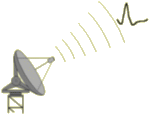|

A system for analysis of human pain signals using a radar tracking approach
Karl Lundin
Master Thesis, Uppsala University, UPTEC F 98 078, Oct 1998.
- Abstract:
- In order to study peripheral neural activity correlating to pain, an analysis tool
that facilitates the investigation of human unmyelinated (C-) fibers has been developed.
The tool calculates important C-fiber data such as latency changes and recovery time
constants, and helps the researcher to present and statistically process data.
By applying electrical stimuli repetitively at 0.25 Hz and additional stimuli, such as
mechanical or chemical, at the receptive field of a studied C-fiber it is possible to
estimate important data. The action potentials (APs) that are evoked by the stimuli are
recorded. The recordings will usually contain APs from several fibers. Our tool has to
determine which C-fiber an AP originated from to be able to get information about the
single fibers.
To associate APs to a single C-fiber automatically, an algorithm from
the radar tracking area, multiple hypothesis tracking (MHT), is used. The APs are
treated as radar targets, and the algorithm tracks and calculates the most probable
traces. After tracking, curves are fitted to each trace and C-fiber data are calculated.
The analysis program consists of three main parts: detection, association (tracking) of
APs and estimation of important constants.
-
-
Thesis Advisors:
-
Björn Hansson,
Mikael Sternad
-
Related publications:
-
Report on the complete algorithm.
SPIE Conference paper on the detection and tracking.
-
Source:
-
|
Related research
|
Main
entry in list of publications
|
|

